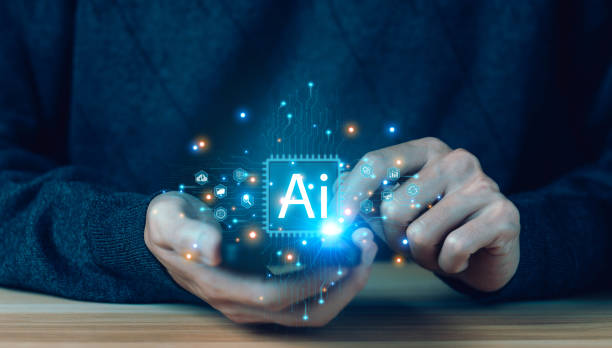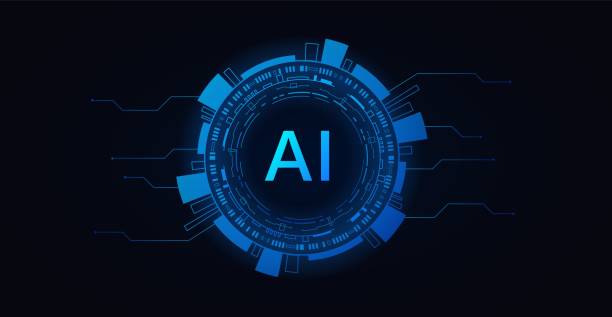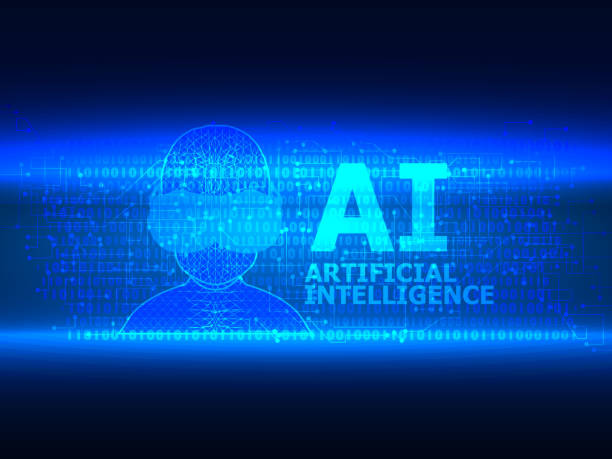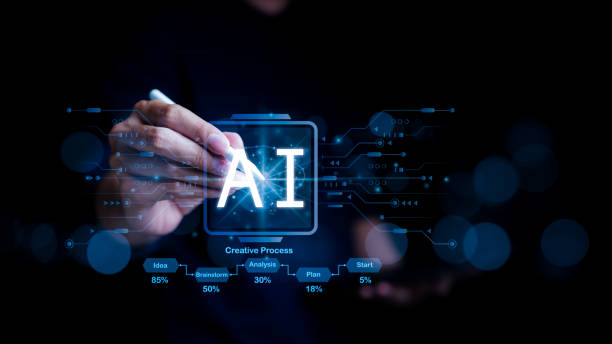What is Artificial Intelligence and How Does it Work?

#Artificial_Intelligence (AI) is a branch of computer science that deals with building machines capable of performing tasks that typically require human intelligence.
These tasks include learning, reasoning, problem-solving, language understanding, and pattern recognition.
Simply put, the goal of AI is to simulate human intelligence in machines.
AI is not just a concept, but a collection of methods and techniques used to achieve the aforementioned goal.
These techniques include Machine Learning Machine Learning, Neural Networks, Natural Language Processing, and many others.
For example, movie recommendation systems in streaming services like Netflix use machine learning algorithms to analyze your viewing history and suggest movies you are likely to enjoy.
AI can work in various ways, but generally, the process is as follows: Data is collected and prepared.
This data can include images, text, audio, or any other type of information.
Machine learning algorithms are used to train AI models based on the collected data.
These models learn patterns and relationships within the data.
Trained models are used for various tasks such as face recognition, language translation, or prediction.
The results obtained by the models are evaluated, and if necessary, the models are retrained to improve their accuracy and performance.
The evolution of AI has been remarkable.
From simple systems that existed in past decades, we have now reached complex systems capable of performing amazing tasks.
Tired of your e-commerce website not generating as much revenue as its potential? Rasaweb, a specialist in professional e-commerce website design, solves this problem for good!
✅ Increase sales and revenue
✅ High loading speed and exceptional user experience
⚡ Get a free consultation for e-commerce website design
Types of Artificial Intelligence: A Deeper Look

Artificial intelligence can be divided into different categories based on capabilities and performance.
The two main classifications are: Narrow AI: This type of AI is designed to perform a specific task and performs very well within that limited domain.
For example, voice assistants like Siri and Alexa are examples of Narrow AI.
They can answer your questions, play music, and set reminders, but they cannot perform tasks they were not designed for.
General AI: This type of AI possesses cognitive abilities similar to humans and can perform any task a human is capable of.
General AI is still in the research and development stages and has not yet been fully realized.
Super AI: This type of AI surpasses human intelligence and can outperform humans in all fields.
Super AI is a hypothetical concept and does not currently exist.
In addition to these classifications, AI can also be categorized based on its learning method: Supervised Learning: In this method, the AI model is trained using labeled data.
Labeled data is data where the expected output for each input is known.
For example, to train an image recognition model, one can use images that are labeled to indicate what is present in each image.
Unsupervised Learning: In this method, the AI model is trained using unlabeled data.
The model must automatically discover patterns and structures within the data.
For example, data related to customer purchasing behavior can be used to identify different customer segments.
Reinforcement Learning: In this method, the AI model learns how to perform a task optimally through trial and error.
The model receives rewards or penalties and tries to improve its performance by choosing actions that yield more rewards.
Applications of Artificial Intelligence in Various Industries

#Artificial_Intelligence has applications in a wide range of industries and is creating fundamental transformations in how things are done.
Some of the most important applications of AI include: Healthcare: AI can be used for disease diagnosis, drug development, and providing personalized care to patients.
For example, AI systems can analyze medical images and diagnose disease symptoms with greater accuracy than human doctors.
Finance: AI can be used for fraud detection, risk management, and providing personalized financial services to customers.
For example, AI algorithms can identify suspicious transactions and prevent fraud.
Transportation: AI can be used for developing self-driving cars, optimizing routes, and improving transportation safety.
For example, self-driving cars use sensors and AI algorithms to detect their surroundings and drive safely.
Manufacturing: AI can be used for automating production processes, improving product quality, and reducing costs.
For example, AI-powered robots can perform tasks that are dangerous or difficult for humans.
In addition to these industries, AI has numerous applications in other fields such as education, agriculture, and energy.
The impact of AI on our daily lives is growing day by day.
From voice assistants that answer our questions to movie recommendation systems that suggest our favorite films, AI is changing how we interact with the world around us.
| Industry | Applications |
|---|---|
| Healthcare | Disease diagnosis, drug development |
| Finance | Fraud detection, risk management |
| Transportation | Self-driving cars, route optimization |
| Manufacturing | Automation, quality improvement |
Machine Learning: The Driving Force of Artificial Intelligence

Machine Learning is one of the most important subfields of artificial intelligence that enables machines to learn from data without explicit programming.
In other words, instead of giving machines precise instructions to perform a task, they are given large amounts of data, and the machines themselves discover patterns and relationships within the data and learn how to perform that task.
Machine learning algorithms use training data to create models that can be used for prediction or decision-making on new data.
These models can be very complex and involve millions or even billions of parameters.
Types of machine learning algorithms include supervised learning, unsupervised learning, and reinforcement learning.
Each of these methods is suitable for solving specific problems.
For example, supervised learning algorithms are used for image recognition, stock price prediction, and spam detection.
Unsupervised learning algorithms are used for customer clustering, identifying hidden patterns in data, and dimensionality reduction.
Reinforcement learning algorithms are used for training robots, playing games, and controlling complex systems.
Article on Machine Learning Applications
Deep Learning is one of the most advanced machine learning methods that uses deep neural networks to learn from data.
Deep neural networks consist of many layers of interconnected nodes, with each layer responsible for extracting specific features from the data.
Deep learning has made significant progress in recent years and has achieved excellent results in areas such as image recognition, natural language processing, and machine translation.
Research shows that 80% of customers trust companies with professional websites more. Does your current site inspire this trust?
With Rasaweb’s corporate website design services, solve the problem of lack of customer trust and weak online image forever!
✅ Create a professional image and increase customer trust
✅ Attract more sales leads and grow your business
⚡ Get a free consultation
Natural Language Processing: Understanding and Generating Human Language

Natural Language Processing (NLP) is a branch of artificial intelligence that enables machines to understand and generate human language.
The goal of NLP is for machines to be able to communicate with language like humans, extract information from text, and generate new texts.
NLP uses various techniques such as Syntactic Analysis, Semantic Analysis, and Pragmatic Analysis to understand human language.
Syntactic Analysis deals with sentence structure and relationships between words.
Semantic Analysis deals with the meaning of words and sentences.
Pragmatic Analysis deals with the purpose and context of language use.
NLP is used in various applications such as machine translation, text summarization, question answering, and sentiment analysis.
For example, machine translation systems like Google Translate use NLP to translate text from one language to another.
Text summarization systems use NLP to generate short and useful summaries of long texts.
Question answering systems use NLP to answer user questions using information available in databases.
Sentiment analysis systems use NLP to detect emotions in texts, such as customer reviews about a product.
There are many challenges in the field of natural language processing.
Human language is very complex and diverse, making it difficult for machines to fully understand it.
Ambiguity, polysemy, and cultural differences are among the challenges faced by NLP researchers.
However, significant progress has been made in this field, and NLP systems are becoming more powerful day by day.
Challenges and Limitations of Artificial Intelligence

Despite significant advances in the field of artificial intelligence, there are still many challenges and limitations that need to be overcome.
Some of the most important challenges include: Need for large amounts of data: Machine learning algorithms require large amounts of data for training.
Collecting and preparing this data can be time-consuming and costly.
Lack of transparency: Many AI models, especially deep learning models, are very complex, and understanding how they work is difficult.
This can raise concerns about the trustworthiness and accountability of these models.
Bias: If the training data used to train an AI model contains bias, the model itself may also be biased.
This can lead to discrimination and inequality.
Ethical issues: AI can be used for malicious purposes.
For example, AI can be used to build autonomous weapons or create surveillance systems.
Impact on the job market: Automation resulting from AI can lead to the displacement of some jobs.
This can raise concerns about the future of the job market.
The ethical issues of artificial intelligence are very important and must be given serious consideration.
It must be ensured that AI is developed and used responsibly and for the benefit of humanity.
Accountability and responsibility for AI decisions are also important challenges.
If an AI system makes a mistake, who will be responsible? These questions do not yet have definitive answers and require further consideration and discussion.
The Future of Artificial Intelligence: What Can We Expect?

The future of artificial intelligence is very bright and full of possibilities.
It is expected that AI will increasingly penetrate our lives in the coming years and bring about profound changes in various industries.
Some of the most important future trends in AI include: Explainable AI: Efforts to create AI models that are more understandable and transparent.
This can help increase trust in these models and address concerns related to accountability.
Automated AI: Development of systems that can automatically create and train AI models.
This can help reduce costs and accelerate the pace of AI development.
Edge AI: Processing data on edge devices such as mobile phones and cars instead of sending them to the cloud.
This can help reduce latency, increase privacy, and decrease energy consumption.
Quantum AI: Using quantum computers to solve complex problems in the field of artificial intelligence.
This can lead to significant advancements in areas such as machine learning and optimization.
A Look at the Future of AI
It is predicted that artificial intelligence will play a significant role in solving global challenges such as climate change, poverty, and diseases in the future.
However, the challenges and limitations of AI must also be considered, and it must be ensured that this technology is developed and used responsibly and for the benefit of humanity.
| Trend | Description |
|---|---|
| Explainable AI | Increasing transparency and understanding of models |
| Automated AI | Automatic creation and training of models |
| Edge AI | Processing data on edge devices |
| Quantum AI | Use of quantum computers |
The Role of Artificial Intelligence in Sustainable Development

Artificial intelligence can play a significant role in sustainable development.
Sustainable development refers to development that meets the needs of the present generation without compromising the ability of future generations to meet their own needs.
AI can contribute to sustainable development in various areas, including: Natural resource management: AI can be used to optimize the consumption of water, energy, and other natural resources.
For example, AI algorithms can analyze water consumption patterns and provide solutions to reduce water waste.
Sustainable agriculture: AI can be used to increase agricultural productivity, reduce the use of fertilizers and pesticides, and improve water management.
For example, AI-equipped drones can capture aerial images of farms and collect information about crop conditions.
Smart cities: AI can be used to improve traffic management, reduce air pollution, and enhance urban security.
For example, smart lighting systems can adjust street lighting based on natural light levels, reducing energy consumption.
Combating climate change: AI can be used to predict climate change, develop solutions to reduce greenhouse gas emissions, and improve preparedness for natural disasters.
For example, AI models can analyze weather data and predict climate change patterns.
By using artificial intelligence, we can move towards a more sustainable and equitable future.
This technology can help us manage natural resources more responsibly, increase productivity, and improve the quality of life.
Are you dissatisfied with the low conversion rate of visitors to customers on your e-commerce site?
With professional e-commerce website design by Rasaweb, solve this problem forever!
✅ Increase visitor-to-customer conversion rate
✅ Create an excellent user experience and build customer trust
⚡ Get a free consultation
Important Tips for Learning Artificial Intelligence

Learning artificial intelligence can be an exciting and challenging journey.
To succeed in this field, you should pay attention to the following tips: Strong mathematical foundation: AI is built on mathematics.
To deeply understand AI algorithms and concepts, you need a strong mathematical foundation.
Linear algebra, calculus, and statistics are among the most important mathematical topics required for learning AI.
Programming skills: To implement and test AI algorithms, you need strong programming skills.
Python is one of the most popular programming languages for AI.
Appropriate learning resources: There are numerous learning resources available for AI.
Books, online courses, and video tutorials are among these resources.
Choosing appropriate learning resources that match your knowledge level and goals is very important.
Practical projects: The best way to learn AI is by undertaking practical projects.
By doing practical projects, you can apply theoretical concepts in practice and strengthen your skills.
Patience and perseverance: Learning AI is time-consuming and requires patience and perseverance.
Don’t get discouraged and keep striving.
In addition to these tips, participating in online communities and AI conferences can help you connect with other professionals in this field and learn from their experiences.
Artificial Intelligence and Iran’s Future

#Artificial_Intelligence can play a significant role in Iran’s economic and social development.
Iran has high potential for AI development, including: Skilled workforce: Iran has a large number of university graduates in engineering and computer science fields.
This skilled workforce can play an important role in the development and implementation of AI in Iran.
Abundant data: Iran has abundant data that can be used to train AI models.
This data can be collected in various fields such as healthcare, agriculture, and transportation.
Government support: The Iranian government has recognized the importance of AI and is providing support for the development of this technology.
This support can include investment in research and development, providing specialized training, and creating necessary infrastructure.
#Future_of_Artificial_Intelligence
With the development of artificial intelligence, Iran can make progress in various fields, including: Increased productivity: AI can be used for process automation and increasing productivity in various industries.
Development of new industries: AI can help create new and innovative industries in Iran.
Improved quality of life: AI can be used to improve people’s quality of life in various fields such as healthcare, education, and transportation.
AI in Iran
Frequently Asked Questions
| Question | Answer |
|---|---|
| 1. What is Artificial Intelligence (AI)? | It is a branch of computer science that aims to create machines capable of simulating human intelligence and performing tasks that require human thought, such as learning, problem-solving, and decision-making. |
| 2. What are the main types of Artificial Intelligence? | They can be classified into Narrow AI, which focuses on a specific task; General AI, which possesses comprehensive human-like capabilities; and Super AI, which surpasses human intelligence. |
| 3. Name some common applications of Artificial Intelligence in our daily lives. | These include voice assistants (such as Siri and Alexa), recommendation systems (such as Netflix and Amazon), self-driving cars, facial recognition systems, and spam filters. |
| 4. What is the difference between Artificial Intelligence and Machine Learning? | Artificial Intelligence is the broader concept of creating intelligent machines, while Machine Learning is a subset of AI that focuses on enabling systems to learn from data without explicit programming. |
| 5. What is Deep Learning? | It is a subset of Machine Learning that uses multi-layered artificial neural networks (deep neural networks) to process data and discover complex patterns, and it is used in image and speech recognition. |
| 6. What are the main benefits of Artificial Intelligence? | Improving efficiency and productivity, automating repetitive tasks, making better decisions based on big data analysis, and developing solutions for complex problems in fields such as medicine and science. |
| 7. What are the main challenges facing the development and deployment of Artificial Intelligence? | These include the need for vast amounts of high-quality data, privacy and security issues, bias in data and algorithms, and high development and maintenance costs. |
| 8. Does Artificial Intelligence raise ethical or social concerns? | Yes, it raises concerns related to privacy, algorithmic bias, job displacement due to automation, responsibility for errors made by intelligent systems, and the need for a regulatory framework. |
| 9. How can Artificial Intelligence affect the future of the job market? | It can lead to the automation of some routine jobs, but it will also create new jobs that require advanced skills in the development, operation, and maintenance of AI systems. |
| 10. What are some modern or promising technologies in the field of Artificial Intelligence? | These include advanced Natural Language Processing (NLP) (such as large language models like ChatGPT), computer vision, robotics, and Generative AI. |
And other services of Rasaweb Advertising Agency in the field of advertising
- Smart Google Ads: A new service for increasing customer acquisition through the use of real data.
- Smart UI/UX: A new service for increasing click-through rates by optimizing key pages.
- Smart Link Building: A specialized service for growing customer acquisition based on key page optimization.
- Smart Customer Journey Map: An effective tool for improving SEO ranking with the help of an SEO-driven content strategy.
- Smart Advertorials: A creative platform for improving campaign management with custom programming.
And over hundreds of other services in the field of internet advertising, advertising consultation, and organizational solutions
Internet Advertising | Advertising Strategy | Advertorials
Resources
What is Artificial Intelligence and What are its Applications?
Applications of Artificial Intelligence in Today’s World
Practical Guide to Artificial Intelligence in Various Industries
What is Artificial Intelligence and What are its Applications?
? To achieve your big business goals in the digital world, Rasaweb Afarin Digital Marketing Agency is by your side with a professional and results-oriented approach. From personal website design to comprehensive SEO strategies and content marketing, we provide everything you need to be seen and grow.
📍 Tehran, Mirdamad Street, next to Bank Markazi, Southern Kazeroun Alley, Ramin Alley, No. 6



